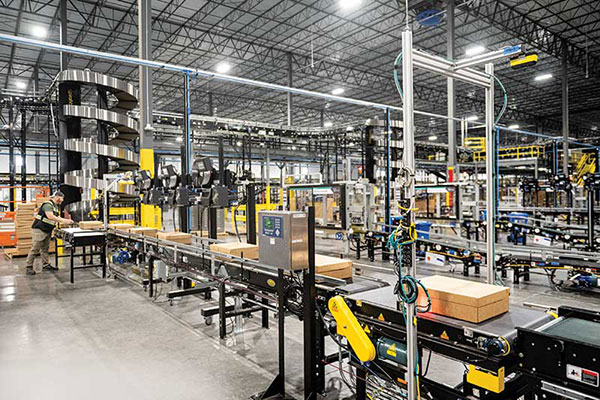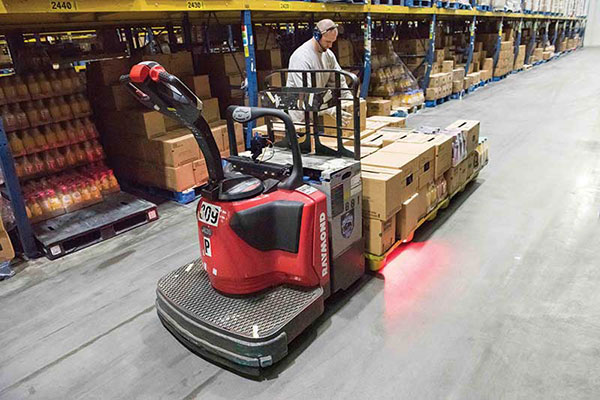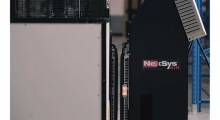It seems that companies have stopped grumbling about how “this warehouse down the street is poaching workers for 25 cents more an hour” and have accepted the reality of the current warehouse labor shortage.
And while the turnover statistics themselves are a bit fuzzy, by some industry estimates, the typical turnover rate for warehousing is around 37% (versus an overall average of 3.6% across all industries right now).
This means that during a 12-month period, 37% of a DC’s or warehouse’s workforce will have exited for greener pastures. And the larger the warehouse, the higher the turnover rate.
Knowing that the situation may not improve anytime soon, companies are coming up with creative ways to offset the problem. Some are infusing more automation into their operations, others are testing out robotics and many others are being creative to ensure their existing labor forces stay put for as long as possible.
These are important moves in a business environment where workforce participation remains at pre-pandemic levels, and where the U.S. Chamber of Commerce says there are 9.5 million job openings and 6.5 million unemployed workers, as of January 2024.
Keith Ingels, lean management manager of solutions and support centers at The Raymond Corporation, credits the retirement of the Baby Boomer workforce as one key driver of current job vacancies in the warehousing sector.
“That’s a big trend that isn’t getting as much publicity as it once did, but with that generation retiring more people are leaving the workforce than entering it at this point,” says Ingels, who advises companies to focus on “continuous improvement” within their operations as a way to “do more with less.”
For example, a company may not have control over the broader labor market, but it can do a better job of routing products in its warehouse, establishing a better flow of goods in the space and rearranging its rack.
“Learn where the congestion or ‘traffic’ is in your warehouse and use a continuous approach to finding solutions to those issues,” Ingels recommends. Start with the process solutions, or those little things that can be tweaked to create a better flow of goods through your operation. Understand that just because an operator is on a forklift doesn’t mean they’re being effective (for example, if they’re stuck in congestion, it’s going to take longer to get the job done).

A Hytrol conveyor feeds a weigh-in-motion scale/dimensioner and three different print-and-apply labeling stations.
Ingels:
“Last summer we implemented a racking solution in a congested area of the warehouse, where units were coming in from both sides in the same aisle. We helped them fix that by creating one-way aisles, which eliminated the backups and the need to pull one lift truck over while another one went through. It smoothed out the whole process.”
That simple adjustment helped the warehouse increase productivity by about 34% without the need to hire additional people. This is just one example of how smart thinking can help fulfillment centers get more value out of their existing labor force. Moves like this also benefit employees, who like to work for companies that put an effort into making their jobs easier.
“Easier is sustainable, easier helps us build in quality and easier makes everything flow better,” says Ingels, who encourages companies to apply continuous improvement to all aspects of labor management, right down to the employee onboarding process.
Ingels Continues:
“The faster you can onboard a new associate and teach them how to add value, the better they’ll be able to contribute. Use the same process you’d use when improving warehouse flow, and come up with ways to create an effective onboarding process using tools like better visuals or by pairing them up with mentors.”
Game On
Employee engagement numbers in the United States are low right now. According to Gallup’s most recent poll, 33% of workers are engaged with their work and 17% are actively disengaged.
Knowing this, some companies are coming up with unique ways to get staff members tuned-in and involved. One strategy that seems to be working well is gamification, or the use of games to get teams working together to achieve a common goal.
The strategy works. Used to create a more interactive and motivating workplace, gaming helps enhance motivation, engagement and productivity in the warehouse or distribution center setting. And according to a new Lucas Systems report, 84% of warehouse employees say they’d be more likely to stay with a company that developed a program featuring competition in the workplace.
Peter Schnorbach, senior director of product management at Manhattan Associates, has seen just how well gaming works in the warehouse setting. Right around the time the pandemic was creating a vacuum in the labor market, Manhattan began building more gamification into its suite of supply chain management applications. The goal was to give employees better visibility into their own performance levels and then reward and recognize the top performers.
As part of this initiative, Manhattan came up with a concept called “challenges” and integrated it into its labor management system (LMS). Employees were “challenged to meet 100% productivity” or “challenged to hit 95% utilization rates.” In some cases, the challenges were as fundamental as showing up for work every day on time. “Every time they complete a challenge over the course of a day or week, they earn points that can be used for a lot of different things,” Schnorbach says.
For example, the points can be posted on a leaderboard so that the employees can see how they’re doing compared to everybody else. Other companies have opened up stores within their warehouses, where employees can cash in points for rewards like Yeti products, game consoles or paid time off.
Schnorbach says companies have seen good results from these initiatives. “We’ve seen some pretty significant results from our customers in terms of the amount of money they’ve saved,” he says. “Some of them have also reduced gap time—the amount of time that workers aren’t doing productive work—and seen their productivity increase.”

Smart thinking can help fulfillment centers get more value out of their existing labor force.
Acknowledging that some employees may see labor management systems as “big brother looking over their shoulder,” Schnorbach says gamification helps assuage those fears and makes workplace competition fun and engaging. “It helps get companies focused on labor productivity and utilization, but in a gamified way that employees like,” he adds.
Optimizing Flow & Reducing Waste
When online golf retailer The Golf Warehouse (TGW) wanted to increase employee engagement, efficiency and productivity across its warehouse operations, it saw an opportunity for improvement within its labor management program. The company also wanted to streamline its inbound process flow by reducing waste across its receiving operations and creating additional capacity in reserve storage locations.
To kick off the project, enVista performed an inbound Kaizen event focused on optimizing flow through the receiving process by implementing the 6S system—sort, set in order, shine, standardize, sustain and safety—to reduce waste and standardize workstations. Once the inbound processes and layout were optimized, TGW needed an LMS to enhance processes within its four walls.
According to Tom Stretar, vice president and labor management practice leader at enVista, the company implemented the enCompass LMS, Manhattan Associates’ WM I-Series and Lucas Systems’ voice-directed picking. It also developed preferred work methods and engineered labor standards (ELS) for replenishment pick/put, picking and packing, autobagging and returns processing.
Stretar says TGW saw significant improvements in its receiving processes, including a 33% decrease in cost-per-unit; a 7.5 hour increase in production for receiving per day; and a 9.3% increase in lines-per-head.
The company also honed its employee training program as a way to stem high turnover and implemented an incentive pay program. These are two areas that Brandon Vallonio, enVista’s project manager of technology, sees as good areas of opportunity for warehouse operators that want to extract more value from existing labor forces. For example, he says companies may want to give out creative “non-cash” rewards (like gas cards, lunch for two at a local restaurant, etc.) to their top performers. “I even saw one company give its top performer a $500 winter coat,” he says.
One of the cooler strategies Vallonio has seen lately involved a warehouse supervisor who had his pickers draft their own “teams” of workers and then go head-to-head, competing against one another to pick with the most speed and accuracy. “It’s about incentivizing competition in a friendly and fun way,” he says, “and it works.”
Become the Employer of Choice
The phrase “employer of choice” has been thrown around a lot in the tight labor market, but it remains a valid and somewhat elusive goal in an industry where 37% employee turnover rates are commonplace.
Evan Danner, president at TZA:
“When you have high turnover, you’re having to constantly start people at zero. We’re at a point where if a company can keep someone in place for 12 to 18 months, that person is considered a ‘long-term employee.’”
Danner says companies can position themselves more favorably in the current labor market by rewarding workers for their efforts. The spoils may be a $200 Amazon gift card, an 80-inch flat-screen TV or even a chance to earn a little more money in every paycheck. “Give them the opportunity to earn more every single day based on their performance,” he says, “and people will want to come work for—and, stay working for—your company.”
Becoming an employer of choice also means having the right processes in place from the time a new hire fills out the job application, through the onboarding process and right out onto the warehouse or DC floor. In other words, make sure the same effort that goes into recruiting is also replicated “on the other side of the wall,” and that new workers aren’t being thrown to the wolves, so to speak.
Danner Continues:
“Have the processes in place to make sure you’re doing everything you can to help reduce turnover. Then, use LMS software to help you establish and execute on that strategy.”
Article topics
Learn More









